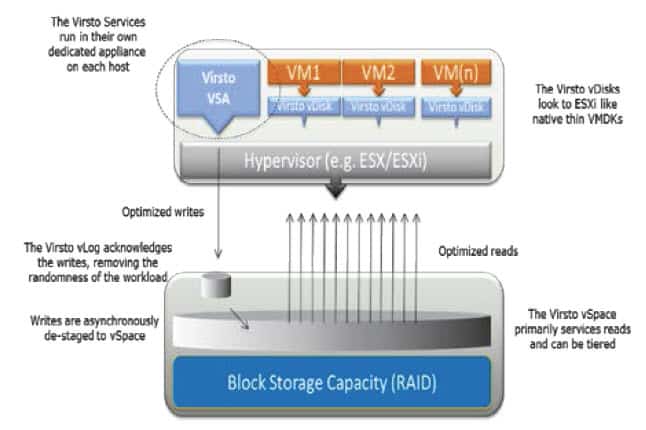Last month at the March San Diego VMUG they had Mark Davis (former CEO) from Virsto give a very informative presentation and some details on why VMware acquired them. I would have gotten this article done sooner, but between getting my new blog site up and other things it’s been sitting in draft form for a month. No longer!
Having never heard of Virsto before, I really had no background in what they did except a vague idea they did something with virtualization and storage. VMware had acquired them literally just weeks before the VMUG presentation, so it was great to hear the CEO’s presentation.
VMware Virsto is, in short, a virtual appliance that acts as an I/O intermediary between the VMs and your physical storage. You can think of it as software defined storage (SDS). The secret sauce is what Virsto does to the I/O to increase performance, decrease latency, mitigate snapshot performance issues, and reduce storage space.
The VMware Virsto VSA is presented RDMs from your physical storage array (NFS stores from your physical array are NOT supported), which it formats with a proprietary file system. The VSA then presents the virtualized storage via a NFS share, which the ESXi host mounts as a datastore. Your VMs then go into the NFS datastore, not a VMFS LUN. I borrowed the diagram below from a Virsto PDF you can find here. In this case a picture is worth a thousand words, so check out the diagram.
Virsto currently supports Hyper-V and vSphere. They also have a vCenter plug-in which has hooks for View and XenDesktop, to accelerate VM provisioning. Whether VMware will kill off the Hyper-V and XenDesktop support is anyone’s guess. I would suspect those features will be retired at some point.
Mark Davis ran through the slides pretty darn fast, and there was a lot of technical content. But I did take some notes:
Software Defined Storage (SDN)
- Virsto for vSphere and Hyper-V
- In deployment since 2009, 75 customers (mostly on Hyper-V)
- Recently released Virsto for VMware (primary market was Hyper-V)
- Storage is the weak link in the virtualization stack
VMware Virsto Software Defined Storage
- Negatives for storage
- Inefficient disk capacity because of VMDK and LUN mismatch (wasted space)
- Data services tied to LUNs and not VMs (many VMs on a LUN that may have different requirements)
- Multitude of device specific management tools
- Can’t use server based SSD and HDD without losing VM mobility
- Hypervisor is a storage I/O blender that makes I/O requests highly random
- Primary cause of storage I/O problems
- Virsto for VMware
- Pure software, VM-centric. HCL is any server that is on the VMware list. Works with any block storage (SAS, SATA, FC, iSCSI, etc.) from any vendor.
- Demonstrated customer value: 9.7x to 56x peak performance increase
- Max storage reduction: 60% – 94%
- Workloads include VDI, SQL server, Oracle (no special modules for VDI/server workloads…does it all)
- Does not require solid state drives, but works with them
- Can make 10s of thousands of new VMs without breaking a sweat (efficient cloning)
- Ideal use cases: VDI, database virtualization, test & dev
- Virsto will remain a separate product for the time being and cost $ (will not be rolled into a vSphere SKU)
- Licensed per TB of used storage space (after de-dupe)
- Virsto Eliminiates Performance Degregration
- One traditional VMware snapshot cuts I/O performance in half
- Virsto provided 416% to 199% improvement in latency and IOPS when it does the snapshot (just a pointer in time)
- Customer Example
- 16 hosts, 300TB storage, SQL Server Databases, 1.5 billion transactions a day
- Storage hardware cost went from $4500 to $1200 (per storage unit was not mentioned)
- Virsto Internal Architecture
- (Today) Installs one VM per host plus a separate management server per datacenter
- Will not talk to NFS, but can use any block storage via RDMs
- A log LUN (vLog) (10s of GBs) per host accepts all the IOs (makes is all sequential) and later destaged to physical disk. Writes are acklowledgfed instantly
Summary
There are lot of VSAs on the market which try and address the storage performance issues that virtualization causes. Atlantis Computing ILIO is aimed at VDI (now expanding to servers), plus several others. Virsto takes an interesting approach, and is designed for all workload types. Mark mentioned that now they have access to the VMware source code they’ve had had some ‘ah ha’ moments, wondering why some of the ESXi APIs were behaving the way they were. So I can only imagine that over the next several releases that their performance and integration will increase.
For the time being the product will be standalone, and require additional expenditure. Mark said this was needed to ensure product development, and that the features won’t be rolled into a vSphere SKU anytime soon. He hinted pieces of it might make it to the base platform, but by in large if you want Virsto you will be paying for it. It is licensed on a per-TB (post de-dupe) basis.





